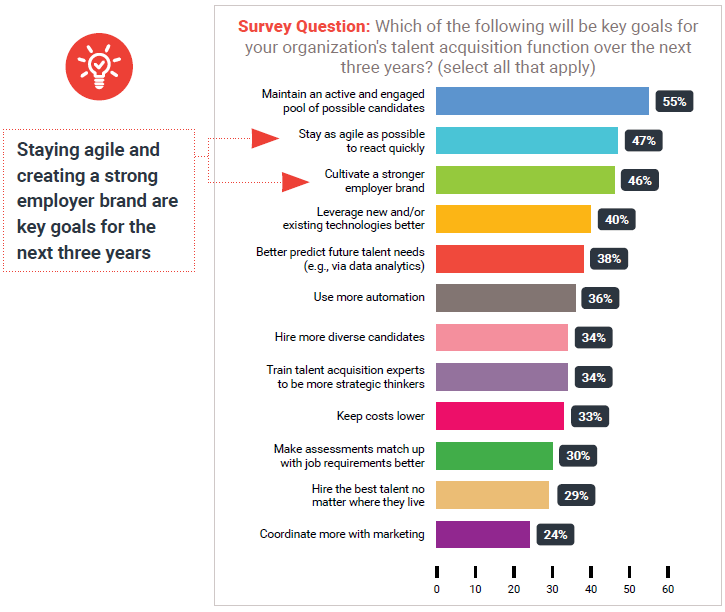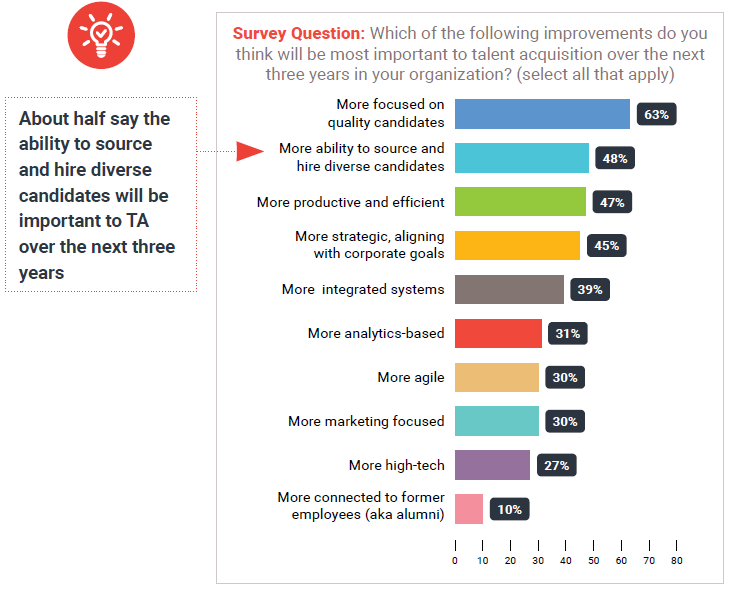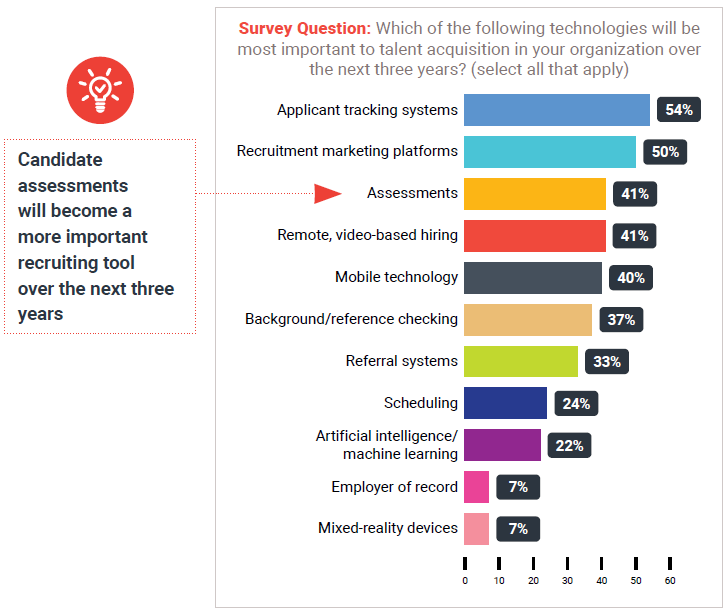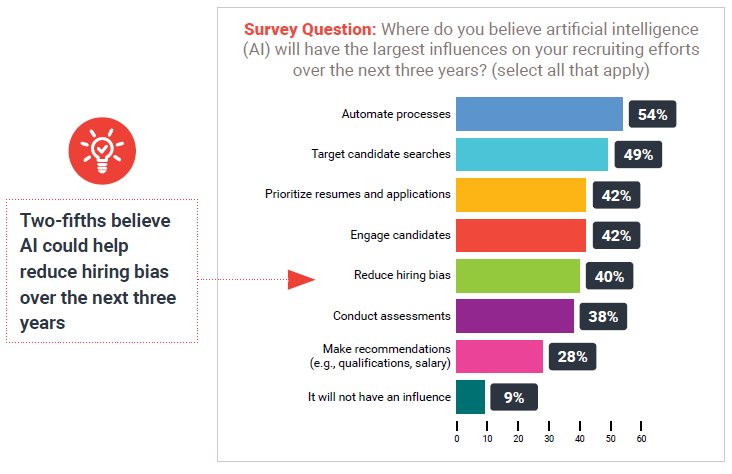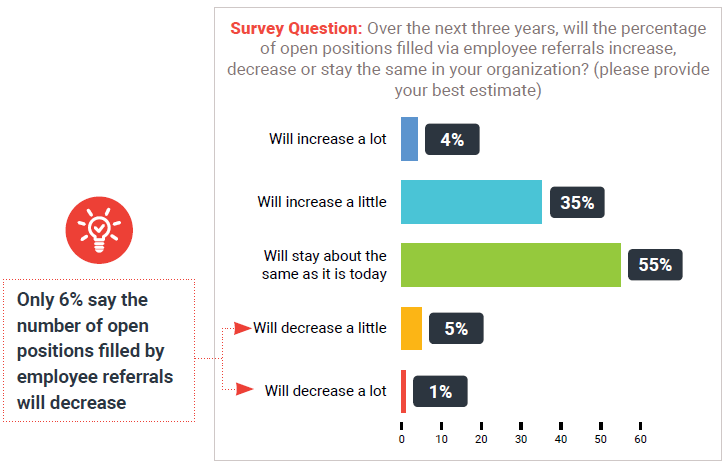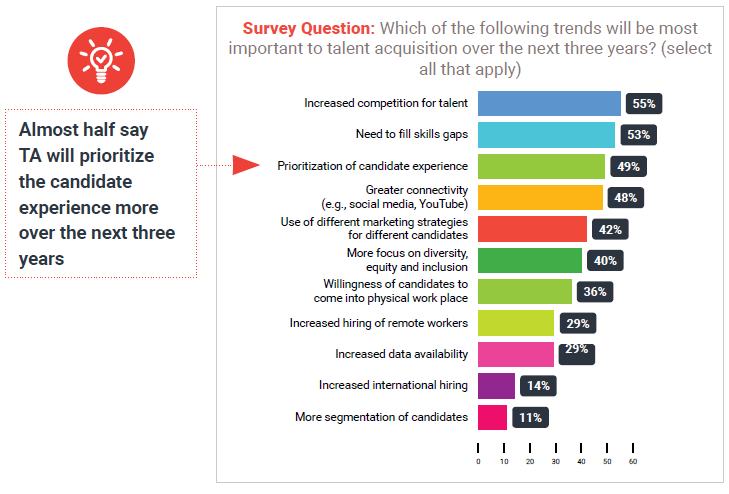The findings above deal with the current state of recruiting. While we can’t predict what the future will look like, we asked participants what they see as the major recruiting trends and challenges down the road.

The most widely cited goal for the next three years is maintaining an active pool of candidates
The top goal for the recruiting function over the next three years, chosen by over half of the respondents, is maintaining an active and engaged pool of possible candidates. The goal here is to have a group of “readynow” candidates that can jump into future open positions, thereby reducing time to hire. This is easier said than done. By using features in marketing applications designed for recruiting, organizations can stay in touch with potential candidates even if they have found other employment.
The next two most widely cited goals are building a stronger employer brand and staying as agile as possible to react quickly. Agility is especially important in today’s fast-changing and hard-to-predict business environment, and a stronger employer brand—much like a good consumer brand—deals with the reputation of your organization as a good place to work. This reputation strongly influences the firm’s ability to attract quality job candidates.
Improving hiring quality is the most critical area for future recruitment success
What recruitment-related improvements will be most important over the next three years? Nearly two-thirds say that improving their focus on quality candidates will be the most critical area of improvement. We think that the quality of the candidate interviewing processes and the use of assessments will play a larger role in qualifying candidates.
Forty-eight percent say the improved ability to source and hire more diverse candidates will become more important. The third most frequently cited area for improvement is the productivity and efficiency of the recruiting function. This will require a closer look at recruitment processes, personnel and technologies.
Applicant tracking systems (ATS) will remain the most important technology over the next three years
Fifty-four percent say applicant tracking systems (ATS) will be among the most important technologies for talent acquisition over the next three years. This suggests that ATS will continue to be the backbone of many recruitment functions, enabling organizations to more easily collect, organize and track candidates through the entire hiring process.
Nearly as many (50%) say recruitment marketing platforms will be important to talent management over the next three years. These platforms can better allow organizations to better reach, attract and source qualified candidates. They can also help the organization measure the effectiveness of their sources and channels so that they can make more informed decisions about recruitment marketing strategies and budget.
Forty-one percent of respondents say candidate assessments will receive more importance in the future. Applicant testing and assessment tools have been around for decades, but it is only recently that they have become more automated, allowing organizations to administer validated skill-level and competency screens far more quickly and at a lower cost.
AI will play a larger future role
While AI is becoming more commonplace for the recruitment function, we are just on the cusp of realizing its full potential. Many times, AI is embedded within a recruiting application you may already be using. We asked participants to indicate the largest influences AI will have on their future recruiting efforts. Fifty-four percent feel AI will help them automate their recruitment processes.
Another 49% indicate that AI will influence the quality of candidate searches. For example, the increasing use of programmatic advertising is fueled by AI. Forty-two percent expect it will help them prioritize resumes and application. In our opinion, these later two influences will greatly impact the maturity of AI applications, allowing organizations to better match an applicant’s qualifications with those required for each position.
By size of organization
Respondents from mid-sized and larger organizations view AI in a different lens than smaller organizations. Large (63%) and mid-sized (53%) organization rank automating processes as the number one area where AI will influence future recruiting efforts, compared to just 48% for small organizations.
About two-fifths say the number of open positions filled by employee referrals will increase
In some cases, the easiest way to increase hiring speed and quality may be through employee referrals. Employees know your company culture and the nature of various jobs. And they are unlikely to refer someone they hold in low regard. Only a small percentage expect open positions filled by referrals to decrease. Fifty-five percent say referral usage will remain the same.
Nearly two-fifths (39%) expect referrals to increase either a little or a lot over the next three years. Using bonuses or rewards for referrals, a common practice, will help motivate employees to keep their eyes open for candidates. In a real sense, employees are often your best recruiters.
Increased competition for talent will be the most important trend in TA over the next three years
Further bolstering a strong theme throughout this report, 55% say increased competition for talent will be one of the two most important recruiting trends over the next three years, along with the need to fill skill gaps (53%). It appears that most respondents have gotten the message: filling open potions with the right talent will be more challenging than ever before.
We find it encouraging that 49% see the prioritization of the candidate experience as a critical future trend. Getting a qualified candidate to accept a job offer is a two-way street, especially in a tighter labor market. How candidates are treated during the entire recruiting process will likely play a key role in accepting your offers. It’s important to keep in mind that any candidate, whether you make an offer are not, may very well be your current or future customers.
